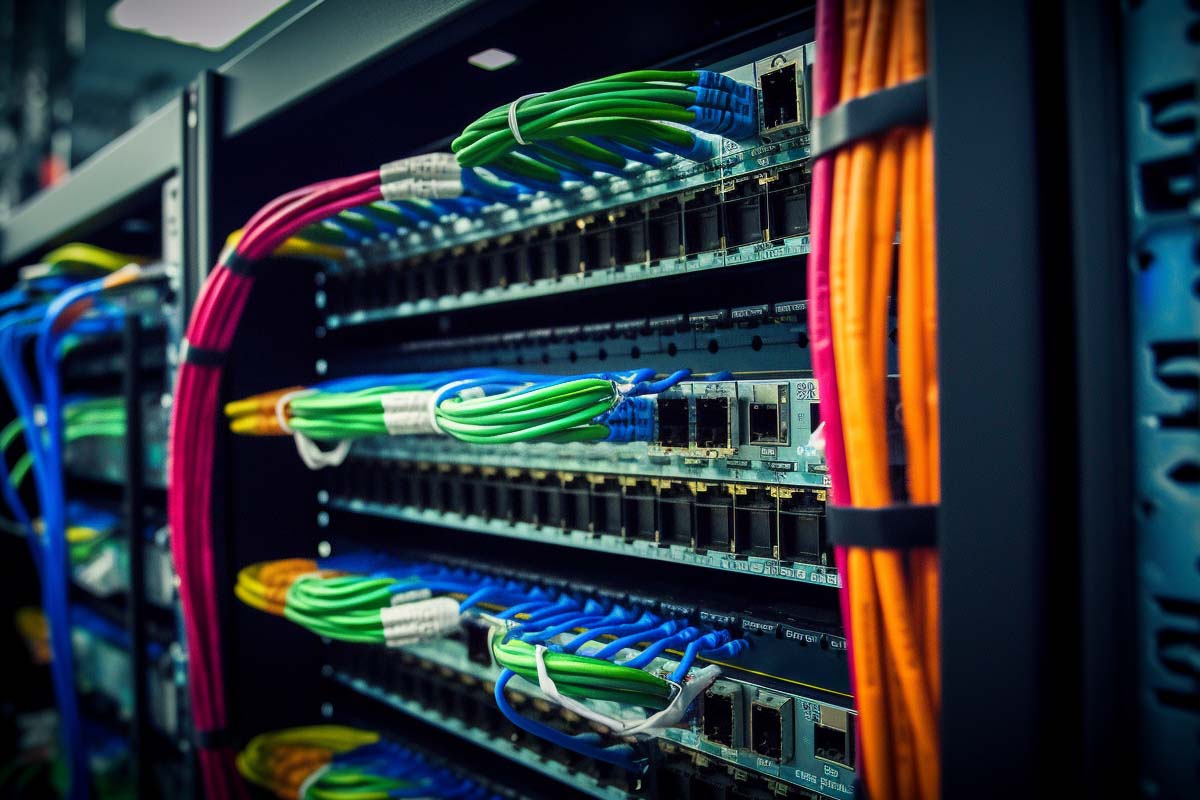Introduction to Patch Panels and Network Cable Management
The Role of Patch Panels in Modern Networking
Patch panels, particularly the widely used 24-port patch panel and its variation, the 24-port Cat6 patch panel, serve as the linchpins of efficient network cable management. They are the unsung heroes in server racks, neatly organizing a multitude of cables and preserving the sanity of network administrators. By understanding the purpose of a patch panel, we can appreciate its role in both simplifying network design and facilitating the smooth operation of a data center.
Streamlining Connectivity: Patch Panel Cable Management
A patch panel, especially when it’s a Cat6 patch bay or an ethernet patch panel, offers an elegant solution to the potential chaos of cable management. With server rack cable management being a critical task, integrating a network patch panel into your setup, whether it’s a home network patch panel or part of a sophisticated data rack, ensures a clean and organized approach to handling the myriad of cables.
Structuring Network Design: The Backbone of Reliable Connections
Incorporating a 24-port patch panel cat 6 into your network rack cable management strategy is more than a neat trick; it’s about maintaining the integrity of your connections. Each port on a patch panel—be it a punch panel, a port patch panel, or even a 1u patch panel—acts as a gateway, ensuring that every cable is correctly routed and easily accessible for both troubleshooting and reconfiguration.
Efficiency in the Data Center: Rack to Rack Cable Management
The conversation about patch panels isn’t complete without addressing the practicality they bring to rack-to-rack cable management. A well-organized server rack with patch panel infrastructure reduces downtime and enhances performance. The back of a patch panel is a testament to this organization, with each connection mapped precisely, allowing for quick adjustments and upgrades.
Concluding Thoughts on Patch Panels: The Heart of Network Infrastructure
As we delve deeper into the specifics of how a patch panel works, we’ll explore the nuanced differences between a patch panel and a switch, the advantages of a rack with a patch panel, and how a server rack patch panel can be a game-changer in your network’s architecture. Understanding these details is not just for clarity—it’s about recognizing the essential nature of patch panels, like the ethernet patch board or the patch panel ethernet switch, in the grand scheme of network engineering.
In the following sections, we will take a granular look at patch panel definitions, explore the various types like the network patch pannel and the server cabinet patch panel, and illustrate how they contribute to a robust network infrastructure. Whether it’s the rack mount patch panel that catches your interest or the versatility of a cable management shelf, we will cover the integral components that keep our networks reliable, manageable, and ready for the future.
Section 1: Understanding Patch Panels
Defining the Patch Panel: A Network’s Nucleus
At its core, a patch panel, such as the ubiquitous 24 port Cat6 patch panel, functions as the nerve center of a network’s cabling system. But what is a patch panel, exactly? It’s a flat panel with multiple ports to connect incoming and outgoing lines, including those of servers, routers, and switches. This central hub is essential for managing and organizing the physical cabling infrastructure of your LAN (Local Area Network), making it a critical component in any network rack.
Anatomy of a Patch Panel: More Than Meets the Eye
Delving into the back of a patch panel reveals its complexity. Here, the convergence of cables from various network locations occurs. Whether it’s a 24 patch panel or a larger 48 port configuration, each port is meticulously designed to provide a junction point for network cables. Understanding the patch panel definition in this context is vital for grasping its role in network design and functionality.
Cat6 Patch Bay: A Testament to Evolution
As network demands have escalated, so has the evolution of patch panels. A Cat6 patch bay represents this growth, accommodating higher speeds and more stringent cabling standards. The transition from Cat5 to Cat6 patch panels illustrates the industry’s move towards efficiency and performance, highlighting the purpose of a patch panel in supporting faster and more reliable connections.
Patch Panel vs. Switch: Distinguishing the Duo
It’s important to differentiate between a patch panel and a switch, as they play distinct roles within the network. A switch is an active element that directs traffic, while a patch panel is passive, serving as a static fixture that guides cables to the switch. Both are integral to network design, but understanding the patch panel’s role is crucial for efficient cable management and organization.
The Keystone of Connectivity: Modular Options
The term ‘keystone’ in networking refers to a specific type of connector that fits into a patch panel or wall plate. These keystones can accommodate various types of connections — from Ethernet to telephone — and allow for a modular approach to network design. A patch panel with keystones adds flexibility, enabling
administrators to customize the panel according to the network’s evolving needs.
Patch Panels in the Rack: A Closer Look at Installation
A rack mount patch panel, such as a 1U patch panel, is typically installed within a server rack, positioned above or below switches for easy access. This setup not only maximizes space within the server rack but also streamlines the cable management process, ensuring that each connection can be traced back to its origin with minimal fuss. Proper installation of a patch panel is as much about precision as it is about practical cable organization.
Cable Patch Panel: The Art of Cable Management
Effective cable management is an art, and a cable patch panel is the artist’s palette. By centralizing cables in one location, network administrators can easily change the path of a connection or troubleshoot issues without sifting through a labyrinth of wires. Patch panel cable management is, therefore, a key component of any network design, saving time and reducing errors during network modifications or expansions.
Enhancing Network Wire Management with Patch Panels
Incorporating a patch panel into your network infrastructure significantly improves wire management. Whether dealing with the delicate fibers of an ethernet patch pannel or the robust cables in an AV rack wire management system, a patch panel ensures that each cable is neatly arranged and clearly labeled. This meticulous organization is pivotal in environments where quick, accurate access to network connections is a daily requirement.
The Future of Patch Panels: Adapting to Changing Needs
As networks grow and change, the ability to adapt becomes crucial. Patch panels are central to this adaptability, providing a straightforward means to connect new devices or reconfigure existing setups. The server cabinet patch panel, for example, allows for future network expansions without the need for complete system overhauls, making it an investment in the network’s future.

Lock In Our Lowest Price Ever For Only $14.99 Monthly Access
Your career in information technology last for years. Technology changes rapidly. An ITU Online IT Training subscription offers you flexible and affordable IT training. With our IT training at your fingertips, your career opportunities are never ending as you grow your skills.
Plus, start today and get 10 free days with no obligation.
Section 2: The Anatomy of a Patch Panel
Exploring the Front: Ports and Labels
The front face of a patch panel is where the action is visible. It features a series of ports—ranging from 24 to 48 or more—each serving as a docking point for a network cable. On a 24 port patch panel, for example, you’ll often find the ports neatly aligned, with clear labeling spaces that facilitate easy identification and mapping. This is crucial for network patch panel organization, as it allows technicians to quickly locate and manage connections.
Behind the Scenes: The Back of a Patch Panel
Turning to the back reveals the structured chaos that makes a network function. Here, cables from various network endpoints converge. The back of a patch panel typically includes punch-down blocks or similar connectors where the individual wires of a Cat5, Cat6, or fiber optic cable are secured. Proper termination at the back of a patch panel is vital for signal integrity and network reliability.
Rack Mount Patch Panel: Fitting Into the Bigger Picture
In the world of network hardware, spatial efficiency is key. A rack mount patch panel is designed to fit seamlessly into a standard 19-inch server rack. The 1U patch panel, standing for one rack unit in height, is a common size, though larger panels may take up more vertical space. This design standardization ensures that patch panels can be integrated into existing server setups without wasting valuable real estate.
The Keystone Concept: Modularity in Design
Keystones are the building blocks of a versatile patch panel setup. They are individual jacks that can be snapped into a patch panel or wall plate, allowing for a variety of connection types in one centralized location. The use of keystone jacks in a patch panel rack system introduces a level of customization that can support a diverse array of devices and cable types within the same framework.
Patch Panel Cable Management: A Tailored Approach
Cable management is a critical aspect of a patch panel’s anatomy. Whether it’s a data rack cable management system or a network rack wire management approach, the goal is
to maintain a neat and orderly arrangement that simplifies troubleshooting and maintenance. This might involve the use of cable management bars, panels, or rings that guide cables to their respective ports while avoiding tangling and strain on the connections.
The Build of a Patch Panel: Materials and Durability
The physical build of a patch panel is designed to withstand the rigors of a network environment. Constructed from durable materials like steel, a server cabinet patch panel is built to last. The choice of material also plays a role in grounding and protecting the network equipment from electromagnetic interference, ensuring consistent performance across all connections.
The Role of Documentation: Keeping Track of Connections
An often overlooked but essential feature of a patch panel’s anatomy is the provision for documentation. This includes the labeling system on the front and the space for circuit diagrams or cable schedules on the inside of the door or on a side panel. Documentation is a best practice that aids in managing the physical layer of the network and is particularly helpful during periods of growth or personnel changes.
The Importance of Standards: T568A and T568B
Patch panels adhere to industry-standard wiring schemes, such as T568A and T568B, ensuring compatibility with network equipment and cable types. These standards dictate the pinout arrangement and color coding for the twisted-pair cables and are crucial for maintaining the proper functioning of the network. Understanding these standards is key for anyone tasked with installing or maintaining a patch panel.
Power Over Ethernet (PoE) and Patch Panels
Modern patch panels often support Power over Ethernet (PoE), enabling them to deliver power to devices through the network cables. This feature simplifies the cabling for devices like VoIP phones and surveillance cameras, reducing the need for additional power sources and streamlining the network’s design even further.
Section 3: Why Use a Patch Panel?
Centralization: The Heart of Network Organization
The primary advantage of employing a patch panel, such as a 24-port Cat6 patch panel, is the centralization it offers. Centralization is key to managing the myriad cables in a network. This central point allows for a consolidated location where all network cables can be managed, making it easier to understand the architecture and flow of the network at a glance.
Scalability: Preparing for Network Growth
Scalability is a crucial factor in network design, and patch panels are at the forefront of this need. A patch panel’s structured setup allows for easy expansions or modifications without overhauling the entire network. Adding new workstations, servers, or additional networking equipment can be accomplished with minimal disruption, thanks to the patch panel’s flexible framework.
Troubleshooting: Simplifying Problem-Solving
With a well-documented patch panel, network issues can be isolated and resolved more efficiently. When a problem arises, technicians can quickly refer to the patch panel’s layout to trace and address connection issues. This streamlined troubleshooting process reduces downtime and ensures that the network remains operational with minimal interruption.
Cable Longevity: Reducing Wear and Tear
Regularly plugging and unplugging cables directly from network equipment can lead to premature wear and tear. Patch panels absorb the physical strain of these connections, which protects the more sensitive and expensive switches and servers from physical damage. By using patch panels, the lifespan of both the cables and the hardware they connect to is significantly extended.
Aesthetics and Safety: Keeping Workspaces Tidy and Secure
A patch panel contributes to a tidy and safe working environment by eliminating the mess of tangled cables that can become a hazard. Well-organized cables not only look professional but also reduce the risk of accidents, such as tripping or unplugging the wrong cable during critical operations.
Cost-Effectiveness: Maximizing Investment and Efficiency
While the initial setup of a patch panel might seem like an added expense, it is cost-effective in the long run. Patch panels help avoid the costs associated with downtime, troubleshooting labor, and the replacement of damaged equipment. Investing in a robust patch panel system can lead to significant savings over time.
Performance: Maintaining Signal Integrity
Contrary to some misconceptions, patch panels do not degrade the signal. Instead, they help maintain signal integrity by providing a stable and secure connection point for all network cables. High-quality patch panels are designed to meet industry standards, ensuring optimal performance for data transmission.
Compliance and Standards: Meeting Industry Requirements
Patch panels are built to adhere to structured cabling standards, which are crucial for compliance in many industries. These standards ensure that the network is reliable, efficient, and ready for future technologies. Compliance also means that the network will be more universally understandable and maintainable by any certified professional.
Choose Your IT Career Path
ITU provides you with a select grouping of courses desgined specfically to guide you on your career path. To help you best succeed, these specialized career path training series offer you all the essentials needed to begin or excel in your choosen IT career.
Section 4: Patch Panels in Action
Real-World Networking: Patch Panels at the Core
In the bustling environment of a modern data center, the patch panel stands as the unsung hero. It’s the central point where the network’s cables—the lifelines of communication—converge. By managing these lifelines, patch panels play a critical role in network operation. They are the physical manifestation of the network’s design, turning abstract diagrams into a tangible, organized array of connections.
The Lifecycle of a Connection
From the initial plugging in of a Cat6 cable into a 24 port patch panel to the moment a technician traces a connection during troubleshooting, the patch panel is actively engaged. Each port on the panel represents a potential avenue for data flow, and the patch panel’s job is to ensure that the data reaches its destination efficiently and reliably.
Cable Management: An Organizational Symphony
A well-organized patch panel is like a symphony orchestra, with each cable playing its part in harmony. Rack cable management accessories, such as cable management panels and shelves, contribute to this organization. They keep cables neatly arranged and out of the way, preventing the dreaded scenario of tangled wires and the potential for disconnections or signal interference.
The Patch Panel’s Role in Network Redesign and Expansion
When the time comes to expand a network, the patch panel proves its worth. It allows for additional devices to be integrated with minimal disruption. For example, incorporating a server rack with a patch panel into an existing setup can be a straightforward task, as the patch panel’s ports are ready to welcome new connections, making the process efficient and orderly.
Patch Panels Supporting Diverse Environments
Whether it’s a robust server cabinet patch panel in a large enterprise or a compact home network patch panel, patch panels serve a broad range of environments. They are not one-size-fits-all but come in various forms to meet the specific needs of the network they support. From small businesses to large data centers, patch panels provide the customization necessary to meet unique demands.
Documentation and Traceability: The Patch Panel’s Memory
One of the patch panel’s key functions is to serve as the network’s memory. With proper documentation, a patch panel holds the history of every connection, providing valuable traceability. This feature becomes indispensable when network changes are frequent, as it allows new technicians to quickly come up to speed on the network’s configuration.
Enhancing Aesthetics and Professionalism
A network rack wire management system that includes a patch panel not only functions efficiently but also looks the part. A neat and professional appearance is often a reflection of the quality of the network installation and management, inspiring confidence in the IT infrastructure.
The Unseen Benefits: Protection and Preservation
Beyond organization, patch panels offer protection for the equipment and the cables themselves. By providing a stable and secure connection point, they reduce the wear and
tear on both the cables and the ports of expensive network equipment, such as switches and servers. This preservation extends the life of the network infrastructure, saving costs and reducing the need for frequent hardware replacements.
Patch Panels: A Testimony to Network Resilience
A network is only as strong as its weakest link. Patch panels contribute to network resilience by allowing for quick reconfigurations, easy scalability, and efficient troubleshooting—all without compromising the network’s integrity. They are a testament to the foresight of network engineers who anticipate the needs of a dynamic networking environment.
The Patch Panel: An Interface Between Innovation and Tradition
As networks evolve with emerging technologies, patch panels serve as the interface between new innovations and traditional infrastructure. They facilitate the integration of cutting-edge technology with existing systems, ensuring that legacy equipment can continue to function alongside new additions without necessitating a complete overhaul of the network.
Cisco CCNA 200-301
The CCNA training is at the associate level, which is for junior network administrators. The 200-301 course validates Cisco skills and is thus valuable for both new IT professionals with some experience in networks as well as experienced network administrators.
Section 5: Technical Deep-Dive: Cat5 vs. Cat6 Patch Panels
Understanding the Categories: Cat5 and Cat6 Defined
Before we compare patch panels, it’s essential to understand the cables they support. Cat5 (Category 5) and Cat6 (Category 6) are classifications of Ethernet cables that differ mainly in their performance specifications. Cat5 cables, including the enhanced Cat5e, support frequencies up to 100 MHz, suitable for networks operating at 10/100 Mbps. In contrast, Cat6 cables support up to 250 MHz, enabling gigabit network speeds that can handle up to 10 Gbps in shorter distances.
The Patch Panel Role: Compatibility and Performance
Patch panels, whether Cat5 or Cat6, serve as static intermediaries in the network. They do not actively improve the performance of the cables connected to them but must match the specifications of the cabling to prevent bottlenecks. A Cat6 patch panel is designed to complement the performance of Cat6 cables, ensuring that the network can operate at its intended speed.
Physical Distinctions: Cat5 vs. Cat6 Panels
While Cat5 and Cat6 patch panels may look outwardly similar, the key differences lie in their internal wiring and construction, which are optimized for their respective cable categories. Cat6 patch panels are built to handle more stringent crosstalk requirements and provide better signal isolation, thanks to their enhanced shielding. This translates to improved performance and reduced chances of interference in a high-speed network environment.
Interoperability: Can You Mix and Match?
A common question that arises is whether Cat5 and Cat6 patch panels are interchangeable. Technically, a Cat6 patch panel can be used with Cat5e cables; it’s backward compatible. However, using a Cat5 patch panel with Cat6 cables is not recommended, as it could lead to a reduction in performance, negating the benefits of the higher-spec Cat6 cabling due to the limitations of the Cat5 panel’s bandwidth capacity.
Signal Integrity: Minimizing Crosstalk
Crosstalk—the electromagnetic interference between different channels—can significantly impact network performance. Cat6 patch panels are designed with tighter twists and better separation between pairs inside the cables, which minimizes crosstalk. When choosing between a Cat5 or Cat6 patch panel, considering the level of signal integrity required for your network operations is crucial.
Future-Proofing Your Network: The Forward-Thinking Choice
When planning for the future, opting for a Cat6 patch panel is often the better investment. As networks move towards higher speeds and greater bandwidth requirements, the enhanced capabilities of Cat6 cabling and compatible patch panels will extend the lifespan of your network infrastructure, supporting newer technologies and higher-speed connections.
Installation Considerations: Termination and Shielding
The termination process for Cat5 and Cat6 cables on their respective patch panels can differ slightly. Cat6 cables are generally thicker due to their increased insulation, which can make termination more challenging. Furthermore, the added shielding in Cat6 cables and patch panels requires careful handling to maintain the grounding and avoid potential performance issues.
Cost Implications: Evaluating the Investment
Cost is an important factor when deciding between Cat5 and Cat6 patch panels. While Cat6 patch panels may come at a higher upfront cost due to their advanced features, they offer better performance and are more future-proof, potentially leading to cost savings in the long run by mitigating the need for near-term upgrades.
Assessing Network Needs: Making the Right Choice
The decision to use a Cat5 or Cat6 patch panel should ultimately be informed by the current and anticipated needs of the network. For applications that do not require high bandwidth or are limited by budget constraints, a Cat5 patch panel may be sufficient. However, for networks that demand high data rates, are expected to scale, or need to support applications like video streaming or data centers, a Cat6 patch panel is the prudent choice.
Network Administrator Career Path
This comprehensive training series is designed to provide both new and experienced network administrators with a robust skillset enabling you to manager current and networks of the future.
Section 6: The Practicalities of Patch Panel Installation
Preparing for Installation: Tools and Planning
The installation of a patch panel is a process that demands precision and foresight. Before beginning, it’s essential to gather the necessary tools, which typically include a punch-down tool, cable testers, and label makers. Planning the layout in advance, considering both current and future cabling needs, will lay the groundwork for a successful installation.
Choosing the Right Location: Accessibility and Airflow
The placement of a patch panel within a server rack or cabinet is not just a matter of convenience; it also affects performance. It should be easily accessible for maintenance and positioned to allow sufficient airflow, preventing equipment from overheating. The standard practice is to mount the patch panel above or below switches and other active equipment to minimize cable clutter.
Rack Mounting: Securing the Patch Panel
Rack-mounted patch panels must be securely attached to the rack with the appropriate screws or cage nuts. Stability is crucial to ensure that the connections do not become loose over time, which could lead to connectivity issues or degraded performance.
Cable Routing: Organized and Efficient
Efficient cable routing is vital to maintaining the integrity of the network. Cables should be neatly organized and directed to avoid stress and potential damage. Employing cable management accessories such as horizontal and vertical managers can aid in maintaining an organized rack space.
Punch-Down Process: Establishing Connections
The punch-down process is where the individual wires of Ethernet cables are securely attached to the patch panel’s terminals. This step must be performed with care
to ensure a solid connection without damaging the wire or the panel. It’s important to follow the color-coding standard (either T568A or T568B) consistently to prevent any miswiring issues.
Testing for Success: Ensuring Connectivity
After all cables have been terminated, it’s essential to test each connection for continuity and performance. Using a cable tester can help identify any issues with the wiring or the panel itself before the network goes live. This step helps to avoid future problems and ensures that the network will function as expected from the start.
Documentation: The Key to Future Maintenance
Once installation and testing are complete, documenting the setup is crucial. Detailed records of what is connected where will save considerable time and effort during future maintenance and troubleshooting. This includes labeling each cable and recording the information in a network diagram or management software.
Addressing Potential Challenges: Overcoming Obstacles
During installation, you may encounter various
challenges such as space constraints, complex cable pathways, or even compatibility issues with existing equipment. It’s important to anticipate these challenges and have contingency plans. For example, using angled or sliding patch panels can mitigate space limitations, while flexible cable conduits can manage complex routing paths.
Compliance with Standards: Ensuring Best Practices
Adhering to industry standards and best practices during the installation of a patch panel is non-negotiable. This adherence ensures that your network meets operational requirements and safety regulations. Compliance not only affects the performance but also the credibility and reliability of your network infrastructure.
Aftercare: Ongoing Inspection and Maintenance
Post-installation, regular inspections and maintenance of the patch panel and associated cabling become part of the network’s lifecycle management. Ensuring that the panel remains dust-free and that all connections are secure will prolong the effectiveness of your network setup.

Lock In Our Lowest Price Ever For Only $14.99 Monthly Access
Your career in information technology last for years. Technology changes rapidly. An ITU Online IT Training subscription offers you flexible and affordable IT training. With our IT training at your fingertips, your career opportunities are never ending as you grow your skills.
Plus, start today and get 10 free days with no obligation.
Section 7: Patch Panel Maintenance and Troubleshooting
Regular Check-Ups: The Foundation of Maintenance
Patch panel maintenance begins with routine inspections. Regularly scheduled check-ups help identify potential issues before they escalate. This includes looking for signs of wear and tear on the cables, ensuring that all connections are secure, and verifying that labels remain clear and accurate.
The Cleanliness Factor: Dust and Debris Management
Dust and debris can accumulate over time in and around the patch panel, which can lead to overheating or connection issues. Periodic cleaning with appropriate tools is necessary to maintain the patch panel’s functionality. However, care must be taken to avoid disrupting the connections during cleaning.
Documentation Updates: Keeping Records Current
As changes are made to the network configuration, it’s essential to update the documentation to reflect the current setup. This includes revising labels on the patch panel and updating network diagrams or management software. Accurate documentation is invaluable for efficient troubleshooting and future modifications.
Troubleshooting Techniques: Identifying and Solving Issues
When network issues arise, troubleshooting starts at the patch panel. The first step is often to check the patch panel for any obvious signs of disconnection or damage. Using a cable tester can help pinpoint the location of faults. It’s also important to trace the cable back to its corresponding port to ensure it hasn’t been inadvertently swapped or mislabeled.
Addressing Signal Quality: Testing and Repair
If signal degradation is suspected, inspecting the quality of the terminations at the patch panel is crucial. Poorly punched-down connections can be re-terminated to improve contact and signal quality. Additionally, ensuring that cables are not bent at sharp angles or overly compressed can help maintain signal integrity.
The Impact of Environmental Factors
Environmental factors such as temperature, humidity, and electromagnetic interference can affect the performance of a patch panel. Monitoring the environment within the server room and taking corrective actions, like adjusting climate control settings or adding shielding, can mitigate these issues.
Upgrading the Patch Panel: When and How
Technology advancements or changes in network demands may necessitate an upgrade to the patch panel. Upgrading from a Cat5 to a Cat6 patch panel, for instance, should be done methodically to minimize downtime. This may involve replacing the panel entirely or simply re-terminating cables to a higher-specification panel.
Training Staff: Empowering Your Team
Proper training of network staff on the intricacies of patch panel maintenance and troubleshooting can significantly reduce the risk of errors. A knowledgeable team is better equipped to maintain the network’s health and respond to issues quickly and effectively.
Developing a Responsive Troubleshooting Protocol
Establishing a standardized troubleshooting protocol ensures that network issues are addressed in a consistent and efficient manner. This protocol should include initial steps for identifying problems, escalation procedures for more complex issues, and guidelines for documenting the resolution process.

Cisco Network Enginner Career Path
Targeting Cisco specific Networks, this Cisco Network Engineer Training series provides in-depth curriculum for those wanting to learn networking basics and advance his/her career opportunities as a Cisco Network Engineer.
Section 8: Patch Panels and Future-Proofing Your Network
Embracing Scalability: The Role of Patch Panels
A fundamental aspect of future-proofing a network is scalability, and patch panels are instrumental in this regard. By providing a structured cabling system, they allow for the network to grow organically without the need for disruptive overhauls. A well-designed patch panel installation anticipates future connectivity needs and accommodates them with minimal adjustments.
The Evolution of Network Speeds and Standards
As network technology evolves, speeds and standards rise accordingly. Patch panels, particularly those designed to handle Cat6 and beyond, are built to support these advancements. Opting for a high-specification patch panel can ensure that your network infrastructure won’t become obsolete as new technologies emerge, maintaining compatibility with faster and more sophisticated equipment.
Modular Design: Flexibility for Technological Shifts
The modular nature of patch panels, especially those with keystone slots, allows for easy updates to different connector types as needed. This adaptability is a key feature of future-proofing, as it enables the network to evolve without replacing the entire panel. As new forms of connectivity arise, the patch panel can be updated simply by changing out keystones, rather than the entire infrastructure.
The Impact of High-Density Patch Panels
High-density patch panels offer a greater number of ports in a compact space, providing a solution for expanding networks without requiring additional square footage. These panels are particularly useful in data centers and other environments where space is at a premium, and they provide a path for expansion that doesn’t necessitate physical expansion of the premises.
Investment in Quality: Longevity and Reliability
Investing in quality
when selecting a patch panel is essential for future-proofing. Higher-quality panels not only offer better performance but are also more durable, ensuring they can withstand the rigors of a dynamic networking environment over time. This longevity is a key component of a future-proof strategy, allowing for gradual upgrades and replacements instead of complete system overhauls.
Preparing for PoE Evolution
Power over Ethernet (PoE) has become increasingly prevalent in powering devices directly over network cables. As PoE standards continue to evolve, providing more power to devices, future-proof patch panels must be capable of handling the increased power loads without degradation to ensure continued efficiency and safety.
Standardization and Best Practices
Adhering to industry standards and best practices in the installation and configuration of patch panels is a forward-looking approach. It ensures that the network remains manageable and maintainable as it grows and changes, and as personnel turnover occurs. Standardized practices facilitate easier upgrades and integrations with new technologies.
The Role of Fiber Optics in Future-Proofing
Considering the integration of fiber optic technology in patch panels is another aspect of future-proofing. Fiber optic cables offer significantly higher speed and bandwidth capacities compared to traditional copper cables. A patch panel that can accommodate fiber connections—or is hybridized to accept both copper and fiber—is preparing the network for a high-speed future.
Section 9: Cost-Benefit Analysis of Patch Panels
Initial Costs: Assessing the Investment
When contemplating the incorporation of patch panels into a network, the initial costs are often the primary focus. These costs include the patch panel itself, which can vary in price depending on the number of ports and the category standard. Additionally, the expenses of cables, labor for installation, and any supplementary equipment such as cable managers or racks must be considered.
Operational Efficiency: Time and Resource Savings
The operational benefits of patch panels can lead to significant time and resource savings. A well-organized patch panel streamlines both daily operations and future expansions. By simplifying cable management, patch panels reduce the time spent on tasks like adding new machines to the network or locating and solving cable-related issues, which translates into cost savings in terms of man-hours.
Minimized Downtime: The Financial Implications
Network downtime can be costly for any business. Efficient troubleshooting facilitated by a well-documented patch panel setup can minimize this downtime. The faster a problem can be identified and fixed, the quicker the network is back up and running, reducing the financial impact of outages.
Long-Term Durability: Reduced Replacement Costs
High-quality patch panels are built to last. Investing in a robust patch panel system may have a higher upfront cost but can reduce the need for frequent replacements. Over time, the durability of a good patch panel can lead to lower total cost of ownership due to reduced maintenance and replacement expenses.
Future Expansion: Avoiding Obsolescence
The scalability offered by patch panels means that future network expansions can be accommodated without significant additional costs. This foresight in network design can avoid the obsolescence of network components, making the initial investment in a patch panel system more cost-effective over the long term.
Enhanced Performance: The Value of Reliability
A reliable network is invaluable, and patch panels contribute to this reliability. They help maintain the quality of the connection, which in turn supports the performance of the network. In the cost-benefit analysis, the value of consistent network performance and the potential avoidance of signal-related issues should be factored in.
Compliance and Standards: Cost Avoidance
Compliance with industry standards is another area where patch panels can save costs. Non-compliance can lead to fines or the need for costly retrofits. By ensuring that the network adheres to current standards with the right patch panel setup, these unnecessary expenses can be avoided.
Resale Value: An Overlooked Benefit
Finally, a well-maintained network infrastructure, including high-quality patch panels, can contribute to the overall value of the IT assets of a company. Should the need arise to liquidate or upgrade components, well-documented and well-maintained patch panels can retain a significant portion of their value, offering a better return on the initial investment.
Section 10: Patch Panels vs. Switches
Defining the Distinct Roles
Understanding the difference between patch panels and switches is fundamental to grasping network infrastructure. While both are essential components of a network, their functions are distinct. A patch panel is a passive device that centralizes cables and serves as a static intermediary in the network. In contrast, a switch is an active device that manages and routes the data packets traveling across the network.
The Patch Panel: Organizational Efficiency
Patch panels primarily contribute to the organization and management of network cables. They do not actively direct traffic but provide a convenient and centralized location for all network cables to terminate. This setup simplifies the process of modifying and troubleshooting the network, as each cable’s path is clear and traceable. In essence, patch panels serve as the network’s physical interface, where the structural layout of the network is made tangible and manageable.
The Switch: Traffic Control and Data Routing
Switches, on the other hand, are the workhorses of the network. They actively manage data traffic, directing packets of information to their intended destinations across the network. Unlike patch panels, switches are electronic devices that require power and possess the intelligence to handle network data efficiently. They make decisions about where to send each data packet based on the destination address contained within the packet itself.
Integration: How Patch Panels and Switches Work Together
In a typical network setup, patch panels and switches are used in tandem. The patch panel organizes and consolidates network cables, making it easier to connect these cables to the switch. This arrangement enhances the physical layout of the network, reduces cable clutter, and facilitates easier access for maintenance or reconfiguration.
Cable Management: Simplified by Patch Panels
The patch panel plays a crucial role in cable management. By neatly organizing network cables, it prevents tangling and clutter, which could otherwise lead to confusion and potential damage. This organized approach is especially beneficial in environments with multiple switches, as it ensures a clear and manageable cable path from the patch panel to each switch.
Performance and Reliability: The Impact of Both Components
While patch panels do not directly influence network performance in terms of data transmission speed or quality, they do contribute to the overall reliability of the network. A well-organized patch panel setup can prevent cable-related issues, making it easier to diagnose and resolve any network problems that arise. Switches, by actively routing traffic, directly impact network performance and efficiency.
Cost Considerations: Investment and Maintenance
When considering costs, patch panels generally require a lower investment compared to switches and have minimal ongoing maintenance costs. Switches, being more complex electronic devices, entail a higher initial cost and may require more maintenance, software updates, and eventual upgrades or replacements.
Section 11: Enhancing Flexibility with Keystones
Introduction to Keystones: Versatile Building Blocks
Keystones are modular jacks or inserts that fit into a patch panel or wall plate, offering a high degree of flexibility in network design. These connectors come in various types and are used to accommodate different kinds of cabling standards, such as Ethernet, telephone, and even audio/video interfaces. Their versatility is key in modern network setups, where adaptability is crucial.
The Role of Keystones in Patch Panels
In the context of patch panels, keystones serve as customizable ports. A keystone-compatible patch panel allows for different types of keystone jacks to be snapped into place as needed. This modularity means that a single patch panel can support a diverse range of connections, from traditional RJ45 Ethernet to fiber optics, and more.
Customization and Future-Proofing
One of the significant advantages of using keystones is the ability to customize and reconfigure the network infrastructure without replacing the entire panel. As networking needs evolve or new technologies emerge, keystones can be easily swapped out or added, providing a cost-effective way to future-proof the network.
Streamlining Network Design
Keystones contribute to a streamlined network design by consolidating various types of connections into a single patch panel. This consolidation reduces clutter and simplifies cable management, making it easier to maintain and modify the network as needed. It also enhances the aesthetic appeal of the network setup, which can be important in customer-facing areas or professional environments.
Ease of Installation and Maintenance
Keystones are designed for ease of installation, often requiring no tools to snap into place on a patch panel or wall plate. This simplicity extends to maintenance and troubleshooting; faulty connections can be quickly identified and corrected by replacing individual keystones, rather than dealing with more complex rewiring.
Broad Compatibility and Interchangeability
Keystone jacks are standardized in size and design, making them broadly compatible with a wide range of patch panels and wall plates. This interchangeability is beneficial for network administrators, as it reduces the need to source specific parts for different network components.
Cost-Effectiveness and Scalability
Investing in a keystone-compatible patch panel system can be cost-effective in the long term. The ability to add, remove, or change keystone types as the network grows or changes can eliminate the need for entirely new panels, reducing overall costs and waste.
Conclusion
- Summarizing the key takeaways about patch panels
- Final thoughts on the importance of patch panels in effective network management
Frequently Asked Questions About Patch Panels
What is a patch panel and why is it important in a network setup?
A patch panel is a device that consolidates multiple network cables into a single location. It simplifies the cabling system by providing an organized, central point for all network cables to connect. Patch panels are important because they facilitate easy management, troubleshooting, and reconfiguration of network connections, improving overall network organization and efficiency.
Can I use a Cat6 patch panel with Cat5e cables?
Yes, you can use Cat6 patch panels with Cat5e cables. Cat6 patch panels are backward compatible with Cat5e cables, meaning they can support the lower performance specifications of Cat5e. However, using Cat5e cables in a Cat6 panel will limit your network to the performance capabilities of Cat5e.
How do I choose the right size patch panel for my network?
The size of the patch panel you need depends on the number of network connections you need to make. Patch panels come in various sizes, typically ranging from 12 to 48 ports or more. Consider the current number of connections and potential future expansion. It’s often advisable to choose a patch panel with more ports than you currently need to accommodate network growth.
What is the difference between a patch panel and a switch?
A patch panel is a passive device that organizes and connects cables in a network but doesn’t actively direct network traffic. A switch, on the other hand, is an active device that receives, processes, and forwards data to the appropriate devices on the network. While a patch panel simplifies cable management, a switch is integral to managing the flow of network data.
How often do patch panels require maintenance?
Patch panels typically require minimal maintenance. Regular visual inspections for loose or damaged cables, periodic cleaning to prevent dust accumulation, and ensuring labels are up-to-date are the primary maintenance tasks. The frequency of these checks can depend on the environment; for instance, dustier environments may require more frequent cleaning.



























